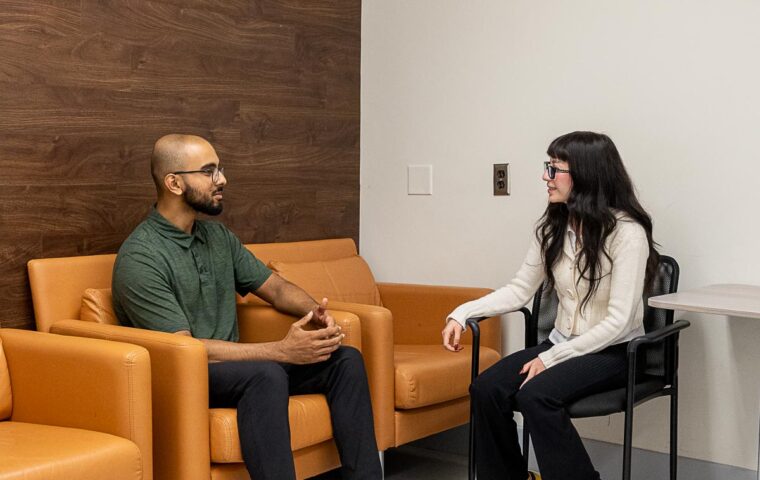Research Laboratory

Leadership
Michele A. Basso, PhD
Director
Contact Info
Fuster Laboratory of Cognitive Neuroscience Website
635 Charles Young Dr.
Los Angeles, CA 90095-7332
mbasso@mednet.ucla.edu
(310) 825-9941
About
The Fuster Lab investigates the brain mechanisms underlying high-level cognitive functions such as memory, attention, and decision-making. Using a combination of neurophysiological recordings and brain imaging, the lab explores how the prefrontal cortex organizes behavior across time. Its research has shaped current understanding of executive function and cognitive control. The lab’s findings inform both theoretical models and clinical approaches to neuropsychiatric disorders. It remains a foundational force in the field of cognitive neuroscience.
People
-

Michele A. Basso, Ph.D.
Research Projects
In Vitro Model of Saccadic Eye Movement
The overall goal of this research plan is to understand the role of the basal ganglia (BG) and superior colliculus (SC) in saccadic eye movement choice and decision-making. This requires developing an in vitro brain slice model with which we will extend our recent in vivo results and investigate the biophysics of a circuit involved in choice and decision-making. The ultimate goal is to link the properties of neurons and their circuits to behavior in order to elucidate the role of the SC and the BG in eye-movement related cognitive processes. We have three Specific Aims: 1) Map response patterns across the SC. Voltage imaging will be used to map the spatial patterns of signal spread following electrical stimulation in the superficial SC (sSC) and intermediate SC (iSC). This aim will provide a basic assessment of the spatial extent of both intra- and inter-laminar circuitry within the SC. 2) Evaluate inhibition and excitation in SC activity patterns. In this aim we will test for the existence of three specific interlaminar pathways: an excitatory pathway arising from the sSC extending to the iSC, an inhibitory pathway arising from the iSC and extending into the sSC and an excitatory pathway arising from the iSC and extending into the sSC. We will use voltage imaging in conjunction with patch clamping to study responses to sSC and iSC stimulation, and resolve these responses into contributions mediated by glutamatergic and GABAergic synapses. Experiments with synaptic receptor agonists and antagonists will assess the role of glutamatergic and GABAergic transmission in both intra- and interlaminar circuits. 3) Determine the influence of BG output on the response pattern across the SC. The experiments of this aim will test the hypothesis that translation of visual information from sSC into motor information in iSC is modulated by inhibition from the substantia nigra pars reticulata of the BG. We will apply electrical stimulation in the nigra to determine how the nigra modulates SC responses to sSC and iSC stimulation. Because the BG is implicated in many neurological and psychiatric disease states, the results of our experiments should lead to important insights into the functioning of these circuits and the biophysical mechanisms underlying complex behavioral and cognitive processing in both health and disease.
Visual Target Selection For Saccadic Eye Movements
The accurate generation of voluntary movements involves neuronal processing related to attention, learning, memory, expectation and planning. Motor systems therefore, are an excellent model to address questions related to perceptual and cognitive processing. The overall goal of my research program is to understand the role of the basal ganglia (BG) and superior colliculus (SC) in target selection for saccadic eye movements. In this application we are focused on the relationship of one output nucleus of the BG, the substantia nigra pars reticulata (SNr) to the SC and their combined role in processing events related to choosing a goal for a saccadic eye movement. A central question in cognitive neuroscience is how visual stimuli are identified as objects for perceptual processing or as goals for movements. We propose that in addition to the role of the BG movement initiation, the BG also actively regulate the information processing occurring within target structures to select goals for movements. Here we propose to use the BG-SC pathway and eye movements as a model system to study this broader movement control issue. As a first step toward exploring the role of the BG as an active player in the sensorimotor events leading to voluntary movements, we will focus on the output pathway from the SNr to the SC. The Specific Aimof this proposal is to determine whether extrinsic inhibitory inputs to the SC arising from the SNr can influence the response field (RF) properties of SC neurons. Four experiments are proposed to accomplish this aim: 1) Measure the location tuning of SC neurons in a Go/No-Go task to test the hypothesis that position information in the SC is altered when a monkey chooses to make a saccade; 2) Measure the contrast sensitivity of SC neurons and determine whether contrast information is altered when a monkey chooses to make a saccade, 3) Electrically stimulate the SNr during the visual, delay and cue periods of the Go/No-Go task to test the hypothesis that increases in SNr activity increase the inhibition on SC neurons and alter the position and contrast sensitivity of SC neurons; 4) Reversibly inactivate the SNr with muscimol, a GABA agonist, and measure the position and contrast tuning of SC neurons to test the hypothesis that decreases in SNr inhibition alter SC neuronal properties. Our overarching hypothesis is that the inhibitory drive to the SC provides a biasing signal to the SC to regulate cortical information transmitted directly to the SC for the selection of targets that lead to saccadic eye movements.
Publications
Powers AS, Basso MA, Evinger C. Blinks slow memory-guided saccades. J Neurophysiol. 2013 Feb;109(3):734-41. doi: 10.1152/jn.00746.2012. Epub 2012 Nov 14.
Vokoun Corinne R, Jackson Meyer B, Basso Michele A Circuit dynamics of the superior colliculus revealed by in vitro voltage imaging.. Annals of the New York Academy of Sciences. 2011; 1233(2): 41-7.
Li Xiaobing, Basso Michele A Cues to move increased information in superior colliculus tuning curves..Journal of neurophysiology. 2011; 106(2): 690-703.
Shires Joel, Joshi Siddhartha, Basso Michele A Shedding new light on the role of the basal ganglia-superior colliculus pathway in eye movements.. Current opinion in neurobiology. 2010; 20(6): 717-25.
Vokoun Corinne R, Jackson Meyer B, Basso Michele A Intralaminar and interlaminar activity within the rodent superior colliculus visualized with voltage imaging.. The Journal of neuroscience : the official journal of the Society for Neuroscience. 2010; 30(32): 10667-82.
Kim Byounghoon, Basso Michele A A probabilistic strategy for understanding action selection.. The Journal of neuroscience : the official journal of the Society for Neuroscience. 2010; 30(6): 2340-55.
Gooding Diane C, Basso Michele A The tell-tale tasks: a review of saccadic research in psychiatric patient populations.. Brain and cognition. 2008; 68(3): 371-90.
Liu Ping, Basso Michele A Substantia nigra stimulation influences monkey superior colliculus neuronal activity bilaterally.. Journal of neurophysiology. 2008; 100(2): 1098-112.
Li Xiaobing, Basso Michele A Preparing to move increases the sensitivity of superior colliculus neurons..The Journal of neuroscience : the official journal of the Society for Neuroscience. 2008; 28(17): 4561-77.
Kim Byounghoon, Basso Michele A Saccade target selection in the superior colliculus: a signal detection theory approach.. The Journal of neuroscience : the official journal of the Society for Neuroscience. 2008; 28(12): 2991-3007.
Utter Amy A, Basso Michele A The basal ganglia: an overview of circuits and function.. Neuroscience and biobehavioral reviews. 2008; 32(3): 333-42.
Basso Michele A, Liu Ping Context-dependent effects of substantia nigra stimulation on eye movements..Journal of neurophysiology. 2007; 97(6): 4129-42.
Smith Joshua J, Hadzic Vezira, Li Xiaobing, Liu Ping, Day Tiffany, Utter Amy, Kim Byounghoon, Washington Ida M, Basso Michele A Objective measures of health and well-being in laboratory rhesus monkeys (Macaca mulatta).. Journal of medical primatology. 2006; 35(6): 388-96.
Li Xiaobing, Kim Byounghoon, Basso Michele A Transient pauses in delay-period activity of superior colliculus neurons.. Journal of neurophysiology. 2006; 95(4): 2252-64.
Li Xiaobing, Basso Michele A Competitive stimulus interactions within single response fields of superior colliculus neurons.. The Journal of neuroscience : the official journal of the Society for Neuroscience. 2005; 25(49): 11357-73.
Basso Michele A, Pokorny Jennifer J, Liu Ping Activity of substantia nigra pars reticulata neurons during smooth pursuit eye movements in monkeys.. The European journal of neuroscience. 2005; 22(2): 448-64.
Basso Michele A, Uhlrich Daniel, Bickford Martha E Cortical function: a view from the thalamus.. Neuron. 2005; 45(4): 485-8.
Williamson Shawn S, Zivotofsky Ari Z, Basso Michele A Modulation of gaze-evoked blinks depends primarily on extraretinal factors.. Journal of neurophysiology. 2005; 93(1): 627-32.
Collaborations
Meyer B Jackson, Ph.D.
The K.C. Cole Professor of Physiology
University of Wisconsin Madison
http://neuro.wisc.edu/faculty/Jackson.asp
William C. Hall, Ph.D.
Professor Nurobiology Duke University
http://neurobiology.duhs.duke.edu/faculty/hall/
Links
National Institutes of Health (NIH)
National Institute of Neurological Disease and Stroke
American Parkinson Disease Association
The McKnight Foundation Neuroscience Resources
Americans for Medical Progress
Foundation for Biomedical Research
Affiliated